Two jackasses were found lollygagging down by the river. Who exactly helped them make their way two hours east to the San Joaquin will most likely never be known. But these weren't just any jackasses. They were our jackasses.
Branded with the insignia of a burgeoning community known as the “town of San José de Guadalupe,” the donkeys most likely belonged to an unsuspecting farmer. At least that’s what a letter purportedly written by failed utopian merchant and private army general John Sutter, dated Feb. 3, 1843, told officials of the town that a century and a half later would become the 10th biggest city in the nation. It was five years before Sutter’s name would become forever wedded to a gold find at his sawmill.
“I presume that these animals were stolen from one of your settlements by Indian horse-thieves,” Sutter wrote. “I therefore have taken charge of the donkeys, so that the owner may send for them. I give you this information in order that you may circulate it if you see fit.”
This letter is among hundreds of documents that were discovered in May, sealed in a combination safe on the second floor of San Jose’s City Hall. They include notes translated from Spanish to English—when San Jose, founded in 1777, was nothing more than a 20-year-old village known as Pueblo de San Jose—to what could be original City Council minutes from 1850–1852. The documents, in total, cover the period of 1792–1852 and may shed new light on the history of the Valley of the Heart’s Delight.
Toni Taber, who took over the city clerk position on a permanent basis last summer, says she had no idea what was inside the lockbox before she and staff opened it. Her main goal was simply to do some housecleaning.
“A couple months ago we decided we were going to open the safe and see what’s in there,” Taber says. “We knew it was full of things, but we didn’t know what it was.”
The documents could be a treasure trove for local historians. In addition to handwritten notes, typed council agenda minutes, beginning with April 13, 1850, are printed on stiff, yellowed paper that bends in on itself like an old man touching his toes. The documents show how a small town council grew from a seven-man group, not including then-Mayor Josiah Belden, to a functioning city with clerk and attorney appointments, where bond payments and disputes large and small were discussed.
Even in those days, tiny San Jose had urban ambitions and sought to ditch its agricultural roots. Two of the first proposed ordinances were “to prevent persons running horses at an immoderate speed through the streets” and “killing cattle within the inhabited parts of this city.” The motion was deferred but later passed. (The penalty for being caught running horses would be $2.)
On April 27, 1850, more than 150 years before the city gave the police chief emergency powers to shut down unruly nightclubs, the council took up public “drunkenness or fighting or otherwise.” Five years before that work had already begun to build the first public primary school.
On May 23, 1850, the council decided to “contract for the hiring of a suitable apartment to serve as a temporary prison,” in addition to instructing the Catholic church to stop building houses on property designated for only places of worship. The council seemed determined to make sure the church did not overextend.
Other notes show that San Jose has always seen itself as a bilingual society. The clerk was instructed from the beginning to compile voter materials in English and Spanish, as were other documents.
On June 10, 1850, the council approved the $2,000 purchase of land from Manuel Pinto for what would become Santa Clara Street, which still serves as downtown San Jose’s main east-west thoroughfare. In addition to the payment, the city also gave up “100 varas square of the outer lots as compensation” for the property. A vara was equivalent to about 33 1/3 inches.
On July 29, 1850, long before the first eight-floor casino was built, the city ordered “gambling houses closed on the Sabbath.”
Taber says the biggest surprise that came from her review of the documents was the translation of election notices into Spanish.
“I’ve received so many complaints over the years in every city in which I’ve worked regarding translating election material into anything other than English, that it was surprising and rather nice to learn that we’ve been translating since 1850,” she says.
But there could be a hitch in the excitement. Jim Reed, curator of archives and library at History San Jose, which was a city entity until the late 1990s, says his office is generally given the first chance to review and maintain historical documents related to city affairs.
The recently discovered documents, however, are expected to be a transferred within the next week to the California Room, which is housed in downtown’s Martin Luther King Jr. Library. The archive center currently holds an assortment of historical pieces, including maps that note parcels of South Bay land going back to 1932, newspaper clippings dating back to 1920 and city directories from South County on up the peninsula, with names of residents, their professions and addresses going back to 1870.
Reed says that he was not aware of the documents until contacted for comment for this story. He sounded dubious that the documents are, in fact, true originals.
“It sounds like something we do have in the pueblo documents,” Reed says. “Those could be transcripts of the originals that we have here.”
Margaret Yamasaki, who took over as senior librarian of the California Room last week, tells Metro she has not seen the documents. But if found to be genuine artifacts, the library would be capable of maintaining them. The California Room possesses two “vaults,” or large rooms that historical documents are housed in—temperature controlled at 57 degrees.
Other items, such as historical pieces of art, including sculptures by renowned 19th-century sculptor Edmonia Lewis, are free to view Tuesday through Saturday 1–6pm.
“That’s sort of what I think is special about this room,” Yamasaki says, “that it’s accessible to the general public.”
Reed says he expects city officials, History San Jose and the California Room’s staff to come together sometime soon to verify the documents’ authenticity.
“We should probably have a chance to see them to see if they’re originals or if they are copies of things we already have in our collection,” he says.
- Lt. Jose Joaquín Moraga founded Pueblo de San Jose in 1777. More than 200 years later, his portrait hangs in the biggest library of the 10th largest city in the nation.
- These handwritten notes appear to be very old and could date back to San Jose’s earliest days.
- Senior librarian Margaret Yamasaki flips through the Sanborn maps, which note the original parcels of San Jose. The maps are located in the California Room.
- These documents contain the first meeting minutes for the City Council of the town de San José de Guadalupe.
- City Clerk Toni Taber discovered the documents in this safe at City Hall.
- Gen. John Sutter wrote this letter to officials of the “town de San José de Guadalupe.”

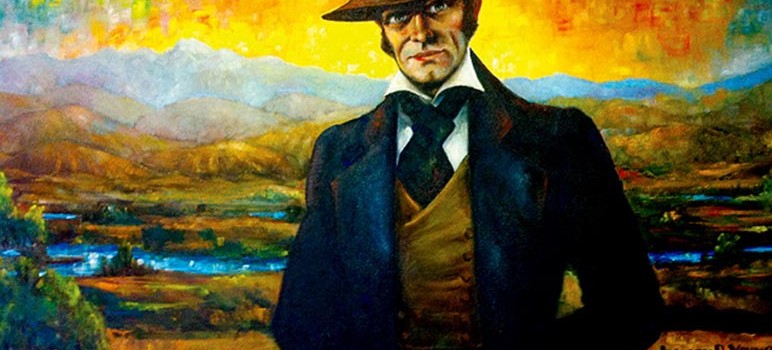
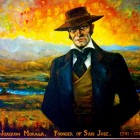
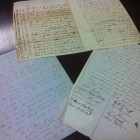
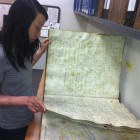
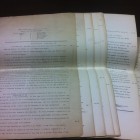

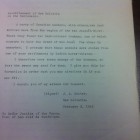
I doubt that Sutter “wrote this letter” (the typed one dated Feb 1843) – and he certainly didn’t type it then. It is probably a rendering someone made of a letter that was actually hand written.
— “Other notes show that San Jose has always seen itself as a bilingual society.”
This would come as a huge surprise to the five or six generations of San Joseans who were educated in English only schools and lived their entire lives under an English only government (and benefitted greatly from the city’s ability to shake itself free of any trace of Mexican or Spanish imperial rule).
But hell, any construction of language that supports the cause of multiculturalism qualifies as good journalism. Real history be damned.
and “Even in those days tiny San Jose had urban ambitions and sought to ditch it’s agricultural roots.”
This would also come as a huge surprise to the generations of farmers who created, grew, and sustained the Valley of Heart’s Delight.
Today’s young journalists just can’t keep themselves from infusing their stories with the urban progressive values with which they’ve been brainwashed. But you’re right finfan- in 2014 America such spin always qualifies as good journalism.
you got that fauxen right….entertainment journalism
Good Job Toni!
Let us all hope your efforts in this matter will stop city officials from compelling the Clerk’s Office from being relocated to anywhere at city hall but the second floor of the Wing where you all deserve to happily stay.
David S. Wall
In 1873, Edmonia Lewis visited San Jose on impulse after failing to sell her sculptures in San Francisco. What was it about the people of San Jose that made it a success for her? For one thing, it had a library!